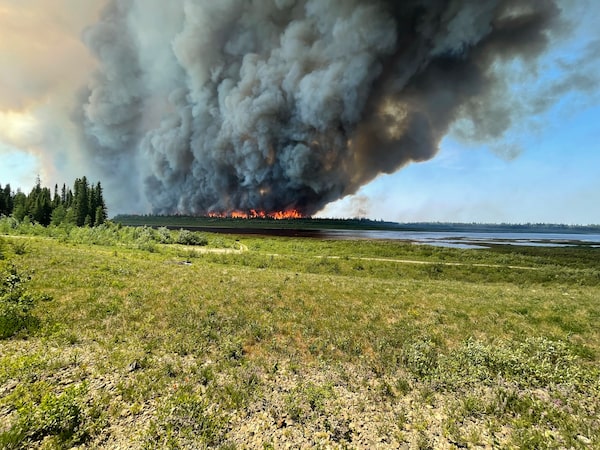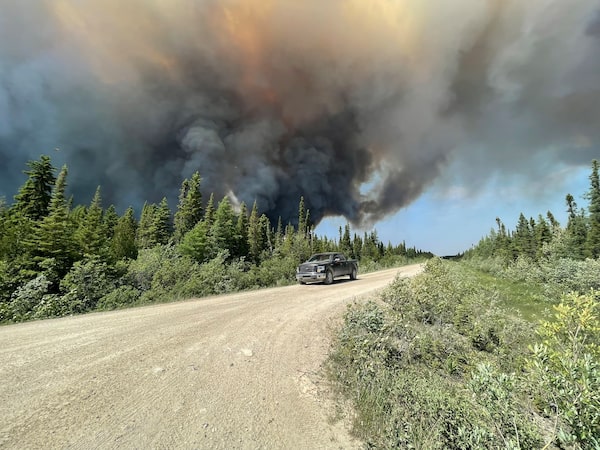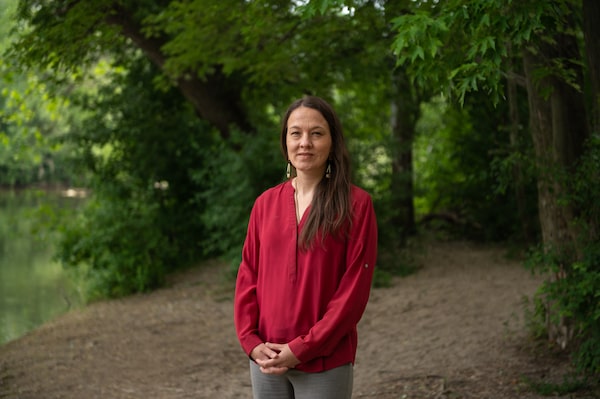
Wildfire near Fort Albany in northern Ontario on July 6, 2023.Elizabeth Kataquapit/Elizabeth Kataquapit
It was around 1 p.m. on June 21 when Chief Elizabeth Kataquapit rushed down the road from Fort Albany First Nation to investigate the big wildfire reported that morning. When she reached the scene, she saw a big black cloud of smoke across the Albany River to the southwest.
The Cochrane 11 wildfire had been burning close to her Northern Ontario community for several days when the wind suddenly picked up and the blaze went out of control. Within a half hour of Chief Kataquapit arriving, the fire jumped across the river to the western side of Sinclair Island, where Fort Albany is located.
“I’ve never seen a forest fire like that – this big anyway,” Ms. Kataquapit said.
She declared a state of emergency and contacted Emergency Management Ontario to arrange planes to evacuate the more than 800 members of the remote fly-in community to Kapuskasing, Ont., 325 kilometres south.
It was not the fire itself that alarmed her most, but the smoke.
“The first thing we were worried about is the smoke coming in and getting suffocated,” Ms. Kataquapit said. Evacuating Fort Albany’s most vulnerable, including pregnant women, children under 5, Elders and those with health conditions, was the priority.
Record-breaking wildfires to continue to burn for months
One hundred of the community’s most vulnerable ended up in Timmins, Ont., more than 400 kilometres south. The rest went to Kapuskasing. After 2 1/2 weeks, people finally returned to Fort Albany on July 8 after the wildfire was downgraded to “under control.”
Crucially, the wind had shifted favourably, making the smoke less of a concern.
For Indigenous communities, it is the smoke, not flames, that accounts for the majority of wildfire-related evacuations. The toxic particles it contains, measured as particulate matter below 2.5 microns in diameter or PM 2.5, are small enough to enter the circulatory system and lower parts of the lungs, where they can cause irritation and exacerbate existing illnesses such as cardiovascular disease and autoimmune conditions. And in a summer of record blazes, this smoke is having a disproportionate effect on Indigenous communities, which already face higher levels of health disparities, have limited resources to fight wildfires and treat affected people and lack shelter that can keep out contaminated air.
“Indigenous people, not only in Canada but also globally, live in closest proximity to nature and, of course, with nature comes forest,” said Nicole Redvers, an associate professor at the Schulich School of Medicine and Dentistry and an expert on the impact of forest fires in Indigenous communities. “It’s just unfortunately natural that when climate change affects nature, it’s going to affect Indigenous people the most.”
The effects of smoke are “almost worse” than the actual fire risk, especially for Indigenous communities, said Amy Cardinal Christianson, an Indigenous fire specialist for Parks Canada, fire research scientist with the Canadian Forest Service and Métis woman from Treaty 8.
Indigenous people make up only 5 per cent of the Canadian population, according to the most recent census data. But according to the Canadian Wildland Fire Evacuation Database (managed by the Canadian Forest Service), Indigenous communities, or communities with a majority Indigenous population, accounted for 42 per cent of all forest-fire-related evacuations from 1980 to 2021. Of those, 32 per cent from 2011 to 2021 were for smoke. Non-Indigenous communities accounted for only 2 per cent of all smoke-related evacuations.
Amy Christianson, who works as an Indigenous fire specialist for Parks Canada, stands in the Edmonton, Alta. river valley on July 7.Kelsey McMillan/The Globe and Mail
In Quebec, heavy smoke led Chief Jean-Claude Mequish of the Atikamekw of Opitciwan to call a state of emergency on June 3. Located more than 600 kilometres north of Montreal, Opitciwan had not seen forest fires of such magnitude for 15 years. Then, little snow this winter followed by three weeks without rain in the late spring allowed forest fires to spread throughout their territory.
According to the Société de protection des forêts contre le feu (SOPFEU), wildfires have burned more than 1.5 million hectares so far this year in Quebec’s “intensive protective zone” – 96 times the annual average for the province over the past 10 years. The three closest fires to Opitciwan have burned more than 29,000 hectares of land, including 15 of the Atikamekw’s traditional campgrounds used by families for cultural purposes.
“A good part of our territory was burned,” Mr. Mequish said. “We, the First Nations, the Atikamekw with our ties to our territory, it had a big impact on our community. We still practise a lot of our way of life. All that has been affected in our community.”
On June 16, as a precaution, Mr. Mequish recommended that 400 vulnerable community members evacuate. Grand Chief Constant Awashish of the Conseil de la Nation Atikamekw said between 250 and 300 of these members chose to leave for other parts of the province, either Roberval, Que., roughly a 4 1/2 hour drive east, or Chicoutimi, Que., approximately six hours east. The evacuation lasted for about a week.
“We have a population of around 2,600. That’s a lot of the people who were evacuated. Pregnant women, children under 2, seniors too,” Mr. Mequish said.
One problem with evacuating to neighbouring First Nation communities, Dr. Redvers said, is a lack of medical centres that could deal with health complications from wildfires.
“Many of these communities don’t have hospitals. They don’t have large clinics. They usually rely on small nursing stations, particularly if they’re fly-in or boat-in communities. If there are exacerbating events due to the complications from breathing and wildfire smoke, there’s not really the ability to triage and deal with the volume.”

Wildfire smoke near Fort Albany in northern Ontario on July 6, 2023.Elizabeth Kataquapit
Wildfire evacuations last on average 8.8 days, according to a coming research paper by Ms. Cardinal Christianson and her colleagues, however some can last several months. Air evacuations were found to last longer on average because of “additional complexities.”
Even when members do return home, there are still the long-term effects of wildfire smoke to address. As a member of the Deninu K’ue First Nation in the Northwest Territories, Dr. Redvers lived through what became known in Yellowknife as “the summer of smoke.” In 2014, 385 wildfires burned 3.4 million hectares of forest, leading to about 2 1/2 months of consistent heavy smoke.
“I remember just being a haze every day for weeks and weeks,” Dr. Redvers said. “Many people who had asthma just left. They had to leave the territories and make arrangements for their children or for themselves to leave because there was just no escape from the smoke anywhere within the North.”
Courtney Howard, who was working as an emergency-room doctor in the territorial capital at the time, and Doug Ritchie, an environmentalist from the Yellowknife Dene who worked for Ecology North, decided to conduct two studies on how the smoke affected the area. They focused on Yellowknife and the neighbouring Indigenous communities of N’Dilo and Dettah, who together make up a majority Indigenous population.

Dr. Nicole Redvers at the Western University Campus in London, Ont., on June 8.Mac Lai/Schulich School of Medicine & Dentistry
Their quantitative study, published in the medical journal BMJ Open in 2021, used comparative data from 2012 to 2015. It showed that the three communities hit a peak PM 2.5 level of 320.3 micrograms per cubic metre of air, with 43 days above 25 micrograms – far higher than the daily 12 to 15 micrograms average recommended by the World Health Organization. As the length of smoke exposure increased, they found indoor air quality declined, even with doors and windows closed.
“What happens is the building envelope is imperfect, so it totally just depends on your housing construction,” said Dr. Howard, who saw worsening asthma in patients as the smoke increased.
Many buildings in Indigenous communities are “leakier” because of poorer construction, she said. “That just means that the public-health advice to stay inside with the windows closed, which is what you hear as standard when it’s smoky out, doesn’t work as well because the smoke just comes in.”
Their second qualitative study, published earlier in the Canadian Journal of Public Health in 2018, used interviews to track the impact of the smoke from June to September, 2014. It found that the prolonged smoke exposure and isolation, along with experiences of evacuation and disruption in land-based activities, had participants feeling “negative consequences for mental, emotional and physical well-being.”
How evacuations affect people psychologically and spiritually is commonly minimized, Dr. Redvers said. “Oftentimes there’s not a lot of support services for the mental wellness of communities and these evacuation hubs outside of acute trauma.”
Wildfire smoke is going to be a problem for years to come, she said, and better municipal and band council planning is going to be required to deal with it.
Ms. Cardinal Christianson said there have been movements to create smoke havens, or clean-air buildings, in some communities, often through retrofitting with air scrubbers or air purifiers. However, the reality is these solutions are expensive and many Indigenous communities are already underfunded.
“It’s just one more expense when there’s already a huge list of things that the community needs to spend money on,” she said.
Editor’s note: A previous version of this story reported that wildfires had burned more than 1.5 million hectares of land in Quebec. In fact, the area affected is within Quebec’s the "intensive protective zone”, and not across the province. This version has been updated.
 Joy SpearChief-Morris
Joy SpearChief-Morris